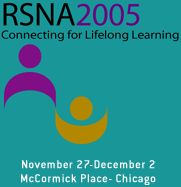
Abstract Archives of the RSNA, 2005
LPR03-06
The Use of a Pneumotachograph for Respiratory Monitoring to Improve the Sensitivity of Oxygen-enhanced MRI
Scientific Posters
Presented on December 1, 2005
Presented as part of LPR03: Chest (MR Perfusion, Technique)
Francesco Molinari MD, Presenter: Nothing to Disclose
Simona Gaudino MD, Abstract Co-Author: Nothing to Disclose
Giuseppe Corbo MD, Abstract Co-Author: Nothing to Disclose
Salvatore Valente MD, Abstract Co-Author: Nothing to Disclose
Tommaso Pirronti MD, Abstract Co-Author: Nothing to Disclose
Lorenzo Bonomo MD, Abstract Co-Author: Nothing to Disclose
To assess the influence of free-breathing and breath-holding in oxygen-enhanced MRI of the lung. To demonstrate the benefits of using a pneumotachograph to reduce respiratory misregistration.
7 healthy volunteers (age range 26-32 years), were imaged with a nonselective IR-SSFSE sequence (TE=26 ms; TI=1200 ms) in a coronal plane on a 1.5-T MR scanner. Cardiac trigger (CT), respiratory trigger (RT), respiratory monitoring with a pneumatic belt (PBm) and respiratory monitoring with a pneumotachograph (PNTCm) were used as methods to reduce the signal variability of the lung due to the cardio-respiratory functions. These methods were tested with both free-breathing and breath-holding technique. Hence, 6 series of 20 images were acquired at room-air breathing: 1) free-breathing without any control of the cardio-respiratory functions (FB); 2) free-breathing with RT (FB-RT); 3) free-breathing with CT (FB-CT); 4) breath-holding with CT and PBm (BH-CT-PBm); 5) breath-holding with CT and PNTCm (BH-CT-PNTCm); 6) breath-holding without CT and with PNTCm (BH-PNTCm). Standard deviations of the lung (SIvar) and diaphragm mismatch (DM) were measured and compared among these series (Friedman’s ANOVA, Mann-Whitney U test). All series, except the first one, were repeated while breathing 100% oxygen and then room-air, to complete the paradigm of oxygen-enhanced MRI. Cross-correlation analysis was performed. Mean correlation coefficients (cc) computed from activated pixels in the lung were also compared between the different series.
SIvar and DM averaged between the breath-holding series were significantly lower than those averaged between the free-breathing series (3.68 and 12.11 vs 9.68 and 31.33; p<0.02). cc averaged between the breath-holding series was significantly higher than cc averaged between the free-breathing series (0.85 vs 0.69; p<0.02). The lowest SIvar and the highest cc resulted from BH-CT-PNTC.
Breath-holding reduces the signal variability in the base-line series and increases the correlation coefficients in oxygen-enhanced MRI of the lung. The sensitivity of this functional method is significantly increased by using a pneumotachograph for respiratory monitoring.
To assess the influence of free-breathing and breath-holding in oxygen-enhanced MRI of the lung. To demonstrate the benefits of using a pneumotachograph to reduce respiratory misregistration.
7 healthy volunteers (age range 26-32 years), were imaged with a nonselective IR-SSFSE sequence (TE=26 ms; TI=1200 ms) in a coronal plane on a 1.5-T MR scanner. Cardiac trigger (CT), respiratory trigger (RT), respiratory monitoring with a pneumatic belt (PBm) and respiratory monitoring with a pneumotachograph (PNTCm) were used as methods to reduce the signal variability of the lung due to the cardio-respiratory functions. These methods were tested with both free-breathing and breath-holding technique. Hence, 6 series of 20 images were acquired at room-air breathing: 1) free-breathing without any control of the cardio-respiratory functions (FB); 2) free-breathing with RT (FB-RT); 3) free-breathing with CT (FB-CT); 4) breath-holding with CT and PBm (BH-CT-PBm); 5) breath-holding with CT and PNTCm (BH-CT-PNTCm); 6) breath-holding without CT and with PNTCm (BH-PNTCm). Standard deviations of the lung (SIvar) and diaphragm mismatch (DM) were measured and compared among these series (Friedman’s ANOVA, Mann-Whitney U test). All series, except the first one, were repeated while breathing 100% oxygen and then room-air, to complete the paradigm of oxygen-enhanced MRI. Cross-correlation analysis was performed. Mean correlation coefficients (cc) computed from activated pixels in the lung were also compared between the different series.
SIvar and DM averaged between the breath-holding series were significantly lower than those averaged between the free-breathing series (3.68 and 12.11 vs 9.68 and 31.33; p<0.02). cc averaged between the breath-holding series was significantly higher than cc averaged between the free-breathing series (0.85 vs 0.69; p<0.02). The lowest SIvar and the highest cc resulted from BH-CT-PNTC.
Breath-holding reduces the signal variability in the base-line series and increases the correlation coefficients in oxygen-enhanced MRI of the lung. The sensitivity of this functional method is significantly increased by using a pneumotachograph for respiratory monitoring.
Molinari, F,
Gaudino, S,
Corbo, G,
Valente, S,
Pirronti, T,
Bonomo, L,
The Use of a Pneumotachograph for Respiratory Monitoring to Improve the Sensitivity of Oxygen-enhanced MRI. Radiological Society of North America 2005 Scientific Assembly and Annual Meeting, November 27 - December 2, 2005 ,Chicago IL.
http://archive.rsna.org/2005/4405911.html

